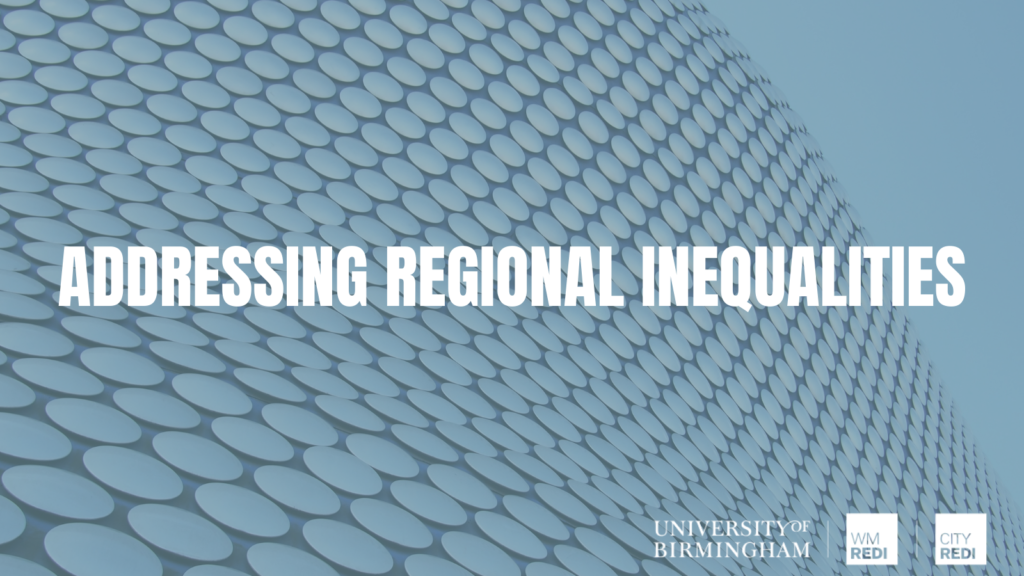
Abigail Taylor discusses a recent project which examines how four city-regions have made progress in reducing regional inequality. This project is associated with our Levelling Up projects and research, you can find out more information here. This is also a collaboration project with The Chartered Institute of Public Finance and Accountancy (CIPFA), you can download the full Investing in Regional Equality - Lessons from four cities report here.
What is the challenge?
Building resilience and inclusivity and supporting local and regional economic development is a crucial concern across governments, particularly in the UK. The UK has high inter-regional differences in productivity and income structures (Davenport and Zaranko, 2020; Fothergill and Gore, 2021). The UK government has recently sought to address interregional inequalities through levelling up.
What did we do?
We conducted policy analysis and interviews with policymakers, academics and third-sector workers in four city regions that have made progress in reducing regional inequalities:
1. Cleveland, United States of America
2. Fukuoka, Japan
3. Leipzig, Germany
4. Nantes, France.
We selected these city-regions selected because they previously all suffered from high levels of inequalities and because they enable examination of policy implementation in different governance structures. Leipzig, for example, suffered mass unemployment and rapid population decline following the reunification of East and West Germany in 1990. But today the city’s economy is one of the fastest-growing in Europe.
What did we find?
Our research identifies common themes across different cities in contrasting governance structures to offer insights into how inter-regional and intra-regional inequalities can be addressed in the UK and elsewhere.
Key factors for success identified across the case studies include:
- Shared political will and partnerships
- Clear strategy and vision
- Investing in the long term
- Local knowledge of the strengths and weaknesses that drive local economies
- Strong monitoring and evaluation systems
- Adapting national frameworks to address local needs
- Diversifying beyond economic and business growth into cultural / spatial development
- The role of key players as enablers of growth
- Adequate and responsive funding

What are the implications?
In the UK context, the research raises questions over the frequent short-term nature of funding and points to the need to ensure greater clarity over what recently announced expanded devolution powers will mean in practice. It also indicates the importance of strengthening relationships between local, regional, and central government stakeholders.
Investing in infrastructure: Enabling fairer growth
Governments around the world have turned to infrastructure development to stimulate economic growth. For this report, we produced case studies of six infrastructure projects across the globe to showcase how alternative systems and approaches can deliver key outcomes to help address regional inequalities.
The case studies focus on city-wide regeneration in Bilbao, Spain; funding for high-priority infrastructure projects that promote economic growth and productivity in New South Wales, Australia; the Øresund Bridge between Sweden and Denmark; a community-led experimental broadband network in Verrua Savoia, Italy; a fund to improve infrastructure in key cities across India and projects designed to promote broadband networks in rural Lithuania.
The research stressed the importance of:
- appropriate financing mechanisms for infrastructure that best reflect the governance structures, fiscal powers and long-term aims of the city / region.
- embedding robust evaluation, monitoring and appraisal mechanisms that are implemented, adjusted and updated throughout the project life cycle.
- fiscal autonomy in developing initiatives.
- well thought-through competitive bidding processes that provide sufficient capability for all to participate and robust appraisal.
- partnership working to unite and provide capacity.
Metrics for designing effective policies
To complement the main report, we also produced a separate metrics report. This details possible metrics that can be used, and in some cases are used, to justify, monitor and evaluate the delivery of strategies to address regional inequalities.
The metrics presented below are not a fully comprehensive list of possible indicators but are identified as frequently used and/or identified as valuable to addressing regional inequalities.

This blog was written by Abigail Taylor, Research Fellow, at City-REDI / WMREDI, University of Birmingham.
Disclaimer:
The views expressed in this analysis post are those of the authors and not necessarily those of City-REDI / WMREDI or the University of Birmingham.
